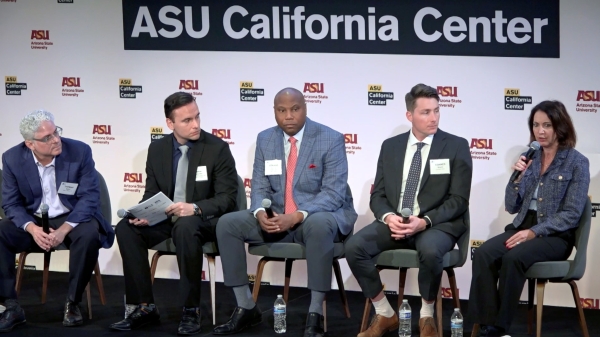On Thursday, President Donald Trump tweeted that Democrats are becoming the “party of late-term abortion.” The contentious issue took up much of an hourlong debate that evening between Judge Michael Mukasey and Nadine Strossen at Old Main on Arizona State University’s Tempe campus.
Their debate was part one of a three-part event that also included a discussion on the necessity of civil discourse and a question-and-answer session with the audience. “How to Have a Civil Conversation Across the Political Divide” was the seventh event in the School of Civic and Economic Thought and Leadership’s yearlong lecture series, “Polarization and Civil Disagreement: Confronting America's Civic Crisis.”
The Walter Cronkite School of Journalism and Mass Communication and the Sandra Day O'Connor College of Law are co-sponsors of the series.
Strossen, a chaired professor at New York Law School and the first woman to serve as president of the American Civil Liberties Union, describes herself as a “liberal-tarian” and added that politically, she falls on the liberal end of the spectrum and has even been called a “bleeding-heart liberal” on issues like abortion and the death penalty.
She kicked off the debate by reminding the audience that both Sandra Day O’Connor and Barry Goldwater, both revered Arizona Republicans, were supporters of reproductive freedom during the landmark 1973 Roe v. Wade case, which concluded that a woman has the constitutional right to terminate a pregnancy up until the point that a fetus has become viable, or potentially able to live outside the mother's womb.
Mukasey, who served as the 81st attorney general of the United States and as a district judge in the U.S. District Court for the Southern District of New York, took issue with the term “viability.” He noted that the state of New York just legalized abortion for the entire period of gestation, up to and including nine months, which he called “barbaric.”
“That road leads to places like Philadelphia, where there is a doctor who is snipping infants’ spinal columns,” Mukasey said, referring to Kermit Gosnell, who was who was convicted of involuntary manslaughter of one woman during an abortion procedure and of murdering three infants who were born alive during attempted abortion procedures.
Furthermore, Mukasey argued that abortion should not be a constitutional issue.
“The country was well on its way toward resolving issues related to abortion before Roe v. Wade,” he said. “Instead, that conversation was cut off and we have a really bitter atmosphere as a result.”
In Mukasey’s opinion, the issue should be resolved by culture, not the courts.
Widely recognized as an expert on constitutional law and civil liberties, Strossen pointed out that abortion is one of those rights that is not explicitly outlined in the Constitution but that is protected by substantive due process.
“Substantive due process is the vegetarian hamburger of constitutional law,” Mukasey replied. “If somebody hands you a vegetarian hamburger, you’re not entirely sure what you’re going to get but one thing you’re damn sure not going to get is a hamburger.”
Despite their disagreements, the two found common ground in that they both consider abortion to be an important issue of morality and ethics that should not be used for political gain.
The other major subject of debate Thursday evening was the implications of free speech and religious liberty laws forbidding discrimination on the basis of sexual orientation.
Moderator James Weinstein, professor in the Sandra Day O’Connor College of Law, referred to the case of Masterpiece Cakeshop v. Colorado Civil Rights Commission, which dealt with whether owners of public accommodations can refuse certain services based on the First Amendment claims of free speech and free exercise of religion, and therefore be granted an exemption from laws ensuring non-discrimination in public accommodation.
The case arose when Colorado baker Jack Phillips refused to make a wedding cake for a gay couple on the basis of his religious beliefs. Mukasey called it a “classic free-speech case.”
“However, that is not what this case is about,” Strossen countered. “The baker Jack Phillips was completely free to say whatever he wanted, express religious beliefs in any way he wanted. What he is not free to do is hang out his shingle, open a commercial business that is open to the general public but say he’s not going to provide services to particular people because of who they are.”
She noted that the same argument was made by opponents of the Civil Rights Act of 1964, claiming that interracial dating went against their religious beliefs.
“You can voice your views, but you cannot implement them through discriminatory conduct,” Strossen said.
Both Mukasey and Strossen were in agreement in response to an audience question about how to restore moderation in political parties that seem to have gone to extremes.
More progress could be made, Mukasey said, if people were willing to align themselves with people they agree with about most things instead of insisting they agree on everything.
“Those who tend to be the most active are the ones who have the strongest views,” Strossen added. “But just as you have the responsibility to vote, you have the responsibility to be active.”
Top photo: Nadine Strossen and Michael Mukasey (right), along with moderator Sandra Day O'Connor College of Law Professor James Weinstein, hold a conversation Thursday that intended to model a civil, mutually respectful and vigorous exchange of ideas on issues that challenge American society, such as abortion. Strossen is a professor at New York Law School and former president of the American Civil Liberties Union. Mukasey served at the 81st attorney general of the United States, appointed by President George W. Bush. Photo by Charlie Leight/ASU Now
More Law, journalism and politics

Exhibit uses rare memorabilia to illustrate evolution of US presidential campaigns
After one of the most contentious elections in history, a new museum exhibit offers a historical perspective on the centuries-old American process.“We The People! Electing the American President” had…

TechTainment conference explores the crossroads of law, technology, entertainment
What protections do writers, actors, producers and others have from AI? Will changing laws around name, image and likeness (NIL) eliminate less lucrative college sports programs?And what does…

How to watch an election
Every election night, adrenaline pumps through newsrooms across the country as journalists take the pulse of democracy. We gathered three veteran reporters — each of them faculty at the Walter…
